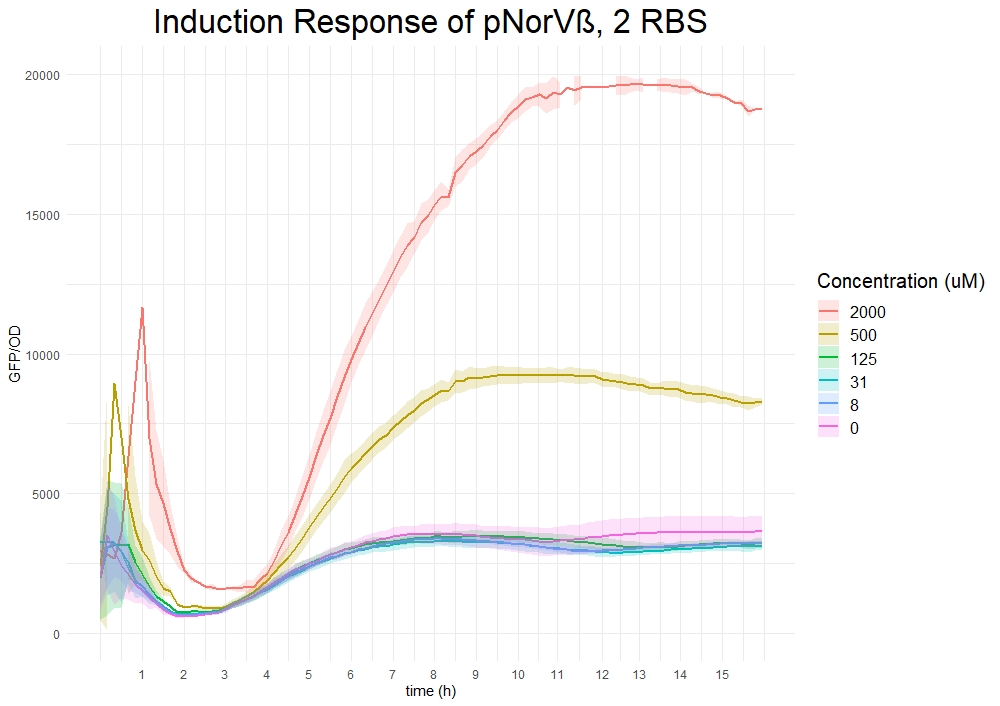Difference between revisions of "Part:BBa K4387006"
| Line 3: | Line 3: | ||
<partinfo>BBa_K4387006 short</partinfo> | <partinfo>BBa_K4387006 short</partinfo> | ||
| − | |||
| − | |||
| − | |||
| − | |||
===Usage and Biology=== | ===Usage and Biology=== | ||
| + | This composite part consists of the inducible pNorVβ promoter (<html><a href="https://parts.igem.org/Part:BBa_K4387000">BBa_K4387000</a></html>), superfolder GFP preceded by two strong ribosomal binding site (<html><a href="https://parts.igem.org/Part:BBa_B0029">BBa_B0029</a></html>, <html><a href="https://parts.igem.org/Part:BBa_B0034">BBa_B0034</a></html>, <html><a href="https://parts.igem.org/Part:BBa_K2553008">BBa_K2553008</a></html>), the NorR regulator (<html><a href="https://parts.igem.org/Part:BBa_K4387001">BBa_K4387001</a></html>), and a double forward (<html><a href="https://parts.igem.org/Part:BBa_B0015">BBa_B0015</a></html>). We chose a high-copy backbone from Twist for this part. Due to the competitive binding of the activated and inactivated NorR on the promoter, we decided on this construct with a positive feedback loop that adjusted the levels of NorR. The presence of nitric oxide would activate pNorVβ to induce GFP and NorR expression. Thereby, we ensure that high amounts of NorR will be produced in the presence of NO and in the presence of NO only. | ||
| + | |||
| + | In the frame of our project, we wanted to improve the construct <html><a href="https://parts.igem.org/Part:BBa_K4387005">BBa_K4387005</a></html> by adding one more ribosomal binding site to see if we could achieve a higher GFP response. According to the data below, we could prove that this construct with two ribosomal binding sites and the codon-optimized NorR was the best and had the highest response. | ||
| + | |||
| + | This construct was tested in the bacterial strain E.coli Nissle 1917. | ||
| + | |||
| + | |||
| + | ===Sequence and Features=== | ||
<!-- --> | <!-- --> | ||
| − | <span class='h3bb' | + | <span class='h3bb'/span> |
<partinfo>BBa_K4387006 SequenceAndFeatures</partinfo> | <partinfo>BBa_K4387006 SequenceAndFeatures</partinfo> | ||
| + | |||
| + | |||
| + | =Characterization= | ||
| + | |||
| + | ===Measurements=== | ||
| + | |||
| + | [[File:DoseResponse2rbs.jpeg|450px|thumb|left|'''Figure 1:''' Induction response of the pNorVβ promoter to different DETA/NO concentrations with respect to time.]] | ||
| + | |||
| + | [[File:Response2rbs.jpeg|450px|thumb|left|'''Figure 2:''' Dose response of the pNorVβ promoter at different DETA/NO concentrations.]] | ||
| Line 18: | Line 31: | ||
<partinfo>BBa_K4387006 parameters</partinfo> | <partinfo>BBa_K4387006 parameters</partinfo> | ||
<!-- --> | <!-- --> | ||
| + | |||
| + | |||
| + | ===References=== | ||
| + | |||
| + | Xiaoyu J. Chen, Baojun Wang, Ian P. Thompson, and Wei E. Huang et al. Rational Design and Characterization of Nitric Oxide Biosensors in E. coli Nissle 1917 and Mini SimCells ACS Synthetic Biology 2021 10 (10), 2566-2578 DOI: 10.1021/acssynbio.1c00223 | ||
Revision as of 12:58, 4 October 2022
Nitric Oxide Sensing Genetic Circuit With Two Ribosomal Binding Sites
Usage and Biology
This composite part consists of the inducible pNorVβ promoter (BBa_K4387000), superfolder GFP preceded by two strong ribosomal binding site (BBa_B0029, BBa_B0034, BBa_K2553008), the NorR regulator (BBa_K4387001), and a double forward (BBa_B0015). We chose a high-copy backbone from Twist for this part. Due to the competitive binding of the activated and inactivated NorR on the promoter, we decided on this construct with a positive feedback loop that adjusted the levels of NorR. The presence of nitric oxide would activate pNorVβ to induce GFP and NorR expression. Thereby, we ensure that high amounts of NorR will be produced in the presence of NO and in the presence of NO only.
In the frame of our project, we wanted to improve the construct BBa_K4387005 by adding one more ribosomal binding site to see if we could achieve a higher GFP response. According to the data below, we could prove that this construct with two ribosomal binding sites and the codon-optimized NorR was the best and had the highest response.
This construct was tested in the bacterial strain E.coli Nissle 1917.
Sequence and Features
- 10COMPATIBLE WITH RFC[10]
- 12COMPATIBLE WITH RFC[12]
- 21INCOMPATIBLE WITH RFC[21]Illegal XhoI site found at 726
- 23COMPATIBLE WITH RFC[23]
- 25COMPATIBLE WITH RFC[25]
- 1000COMPATIBLE WITH RFC[1000]
Characterization
Measurements
References
Xiaoyu J. Chen, Baojun Wang, Ian P. Thompson, and Wei E. Huang et al. Rational Design and Characterization of Nitric Oxide Biosensors in E. coli Nissle 1917 and Mini SimCells ACS Synthetic Biology 2021 10 (10), 2566-2578 DOI: 10.1021/acssynbio.1c00223


